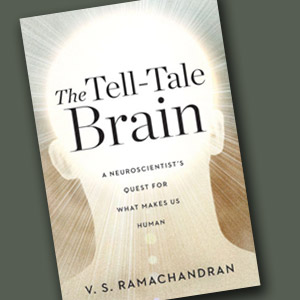Home > Magazine > Desi World > A BRAIN MAN’S GUIDE TO WHAT MAKES US HUMAN
 Call
him Brain Man. Actually a classier title would be Marco Polo of
Neuroscience—which is what the scientist Richard Dawkins once called V.S. Ramachandran. Don’t be surprised if Dr. Ramachandran wins the Nobel Prize one
day. Already his work on phantom limbs, synesthesia, mirror neurons and other
heady stuff makes him a star in his field. And he has a large following among
lay enthusiasts. His new book, The Tell-Tale Brain (W.W. Norton), meant for
general readers, is attracting wide and favorable notice.
Call
him Brain Man. Actually a classier title would be Marco Polo of
Neuroscience—which is what the scientist Richard Dawkins once called V.S. Ramachandran. Don’t be surprised if Dr. Ramachandran wins the Nobel Prize one
day. Already his work on phantom limbs, synesthesia, mirror neurons and other
heady stuff makes him a star in his field. And he has a large following among
lay enthusiasts. His new book, The Tell-Tale Brain (W.W. Norton), meant for
general readers, is attracting wide and favorable notice.
Patients with amputated limbs can still feel their ghostly presence, but they also experience what’s been dubbed phantom pain. Using just ordinary mirrors, Ramachandran was able to fool the brain and bring relief to his patients. The mirror visual feedback (MVF), as it is known, allows the brain to “unlearn” the learned paralysis, even leading to successful amputations of phantom limbs. Ramachandran heads the Center for Brain and Cognition at the University of California, San Diego, where he is also a Distinguished Professor with the Psychology Department and Neurosciences Program.
The author of two previous books, including Phantoms in the Brain, Ramachandran charts neuroscience’s rapid advances in recent years, with an emphasis on the path-breaking research he and his colleagues have done. The other topics he explores include autism, language evolution and aesthetics. Ramachandran’s ability to probe human consciousness—especially by studying brain disorders—and convey his findings lucidly to ordinary readers puts him in the company of Oliver Sacks and Francis Crick, both of whom he cites as influences.
Low-tech methods to solve deep-rooted problems are a hallmark of Ramachandran’s work. “When I say I prefer Q-tips and mirrors to brain scanners and gene sequencers, I don’t mean to give you the impression that I eschew technology entirely. (Just think of doing biology without a microscope!),” he writes, adding, “My point is that science should be question driven, not methodology driven.”
blog comments powered by Disqus
A BRAIN MAN’S GUIDE TO WHAT MAKES US HUMAN
March 2011
 Call
him Brain Man. Actually a classier title would be Marco Polo of
Neuroscience—which is what the scientist Richard Dawkins once called V.S. Ramachandran. Don’t be surprised if Dr. Ramachandran wins the Nobel Prize one
day. Already his work on phantom limbs, synesthesia, mirror neurons and other
heady stuff makes him a star in his field. And he has a large following among
lay enthusiasts. His new book, The Tell-Tale Brain (W.W. Norton), meant for
general readers, is attracting wide and favorable notice.
Call
him Brain Man. Actually a classier title would be Marco Polo of
Neuroscience—which is what the scientist Richard Dawkins once called V.S. Ramachandran. Don’t be surprised if Dr. Ramachandran wins the Nobel Prize one
day. Already his work on phantom limbs, synesthesia, mirror neurons and other
heady stuff makes him a star in his field. And he has a large following among
lay enthusiasts. His new book, The Tell-Tale Brain (W.W. Norton), meant for
general readers, is attracting wide and favorable notice. Patients with amputated limbs can still feel their ghostly presence, but they also experience what’s been dubbed phantom pain. Using just ordinary mirrors, Ramachandran was able to fool the brain and bring relief to his patients. The mirror visual feedback (MVF), as it is known, allows the brain to “unlearn” the learned paralysis, even leading to successful amputations of phantom limbs. Ramachandran heads the Center for Brain and Cognition at the University of California, San Diego, where he is also a Distinguished Professor with the Psychology Department and Neurosciences Program.
The author of two previous books, including Phantoms in the Brain, Ramachandran charts neuroscience’s rapid advances in recent years, with an emphasis on the path-breaking research he and his colleagues have done. The other topics he explores include autism, language evolution and aesthetics. Ramachandran’s ability to probe human consciousness—especially by studying brain disorders—and convey his findings lucidly to ordinary readers puts him in the company of Oliver Sacks and Francis Crick, both of whom he cites as influences.
Low-tech methods to solve deep-rooted problems are a hallmark of Ramachandran’s work. “When I say I prefer Q-tips and mirrors to brain scanners and gene sequencers, I don’t mean to give you the impression that I eschew technology entirely. (Just think of doing biology without a microscope!),” he writes, adding, “My point is that science should be question driven, not methodology driven.”
Enjoyed reading Khabar magazine? Subscribe to Khabar and get a full digital copy of this Indian-American community magazine.
blog comments powered by Disqus










